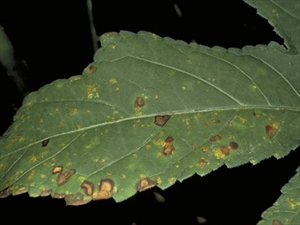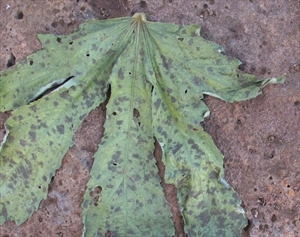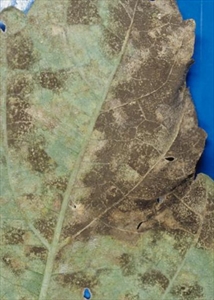- Worldwide distribution. A minor disease of bele on older leaves, but important on okra.
- Leaf spots, circular to irregular, often limited by the veins, brown with blackish brown margins on the upper leaf surface and pale brown mould below. Sometimes, olive-brown to blackish-brown, indistinct angular leaf blotches occur instead of spots. Severely affected leaves turn yellow, roll, wilt, and fall.
- Spread is by spores blown by wind. Survival is in crop debris.
- Cultural control: avoid planting new crops next to infected; remove older infected leaves, and burn them; when harvesting young leaves (bele) or fruit (okra);collect and destroy debris after final harvest; crop rotation.
- Chemical control: use chlorothalonil, copper or mancozeb.
Pacific Pests, Pathogens and Weeds - Online edition
Pacific Pests, Pathogens, Weeds & Pesticides
Bele (Abelmoschus) leaf blotch (322)
Leaf mould, leaf blotch
Pseudocercospora abelmoschi; previously Cercospora abelmoschi, Oidium abelmoschi.
AUTHORS Grahame Jackson & Eric McKenzie
Information from Pseudocercospora abelmoschi. Editor Bob Macfarlane. Ecoport: (http://ecoport.org/ep?Fungus=23085&entityType=FU****&entityDisplayCategory=full); and from (including Photos 1,2&4) McKenzie E (2013) Pseudocercospora abelmoschi: PaDIL - (http://www.padil.gov.au).
Produced with support from the Australian Centre for International Agricultural Research under project PC/2010/090: Strengthening integrated crop management research in the Pacific Islands in support of sustainable intensification of high-value crop production, implemented by the University of Queensland and the Secretariat of the Pacific Community.







